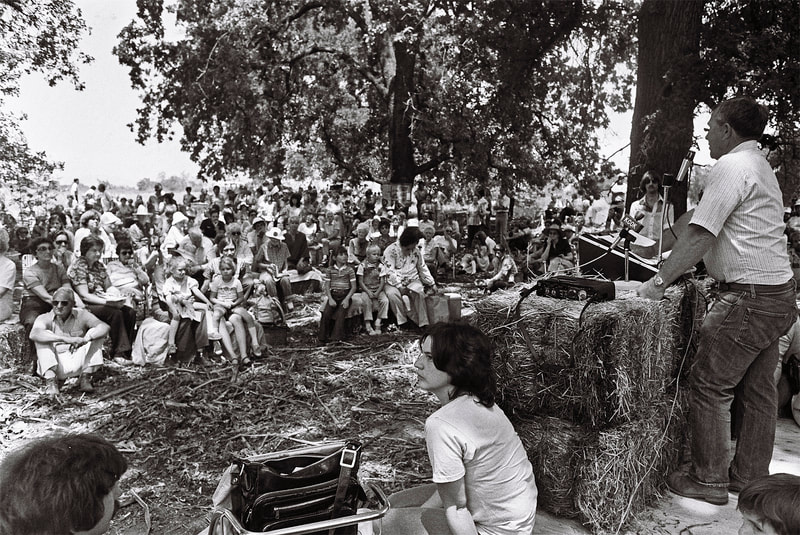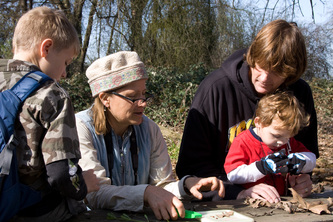|
|
KAWEAH OAKS PRESERVEEnvironment: Valley, riparian, Valley oak woodlands Activities: birdwatching, dog walking (on a 6' leash; scoop poop), educational activities, hiking, photography, picnicking Open: Winter: 8:00 a.m. – 5:00 p.m., Summer: 8:00 a.m. – 7:00 p.m., Spring/Fall: 8:00 a.m. – 6:00 p.m.; free admission (donations accepted) Site Steward: Sequoia Riverlands Trust (SRT); 559-738-0211 Opportunities: donate, volunteer Links: Sequoia Riverlands Trust, Kaweah Oaks Preserve, The Nature Conservancy Directions: Map and directions are at the bottom of this page. |
 Alan George, "Mr. Oak"
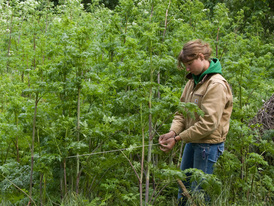 Volunteer Measuring
"And the world cannot be discovered by a journey of miles, no matter how long, but only by a spiritual journey, a journey of one inch, very arduous and humbling and joyful, by which we arrive at the ground at our feet, and learn to be at home."
-- Wendell Berry 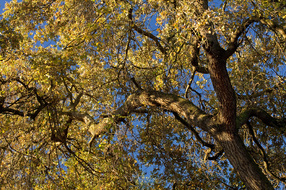
"Around me the trees stir in their leaves
and call out, 'Stay awhile.' The light flows from their branches. And they call again, 'It's simple,' they say, 'and you, too, have come into the world to do this, to go easy, to be filled with light, and to shine.'" -- Mary Oliver 
“In a place where recorded history is so short and the people so transient, the few remaining valley oak trees stand out with their deep-rooted pasts. Some are six hundred years old. Their trunks, which reach diameters of nine feet, are strong enough, considering the sail effect of their large canopies, to withstand the spring winds that sweep across the valley. The trees are huge and many-limbed in a graceful, drooping sort of way." -- Philip L. Fradkin
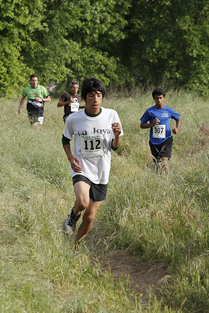
"As for myself, I swung the door open. And there was the wordless, singing world. And I ran for my life." -- Mary Oliver Photos for this article by: John Greening, Greg & Laurie Schwaller; and courtesy of Rob Hansen and Sequoia Riverlands Ttust
|
History:
The Story of the Kaweah Oaks Preserve by Louise Jackson As far as the eye could see, there were oak trees -- over four hundred square miles of woodlands stretching westward from the Sierra Nevada foothills to the vast Tulare Lake. When the first Spanish and American explorers came into the southern San Joaquin Valley almost two hundred years ago, they struggled for days through a maze of rivers, wetlands, and towering trees. The riparian landscape of the Kaweah River delta was especially formidable with thickets of willows, tangled wild grape vines, elderberries, and blackberries. It was so marshy, particularly during the annual winter flood season, that the local Yokuts people could not live in it. They fished in its ponds and streams, hunted its great variety of wildlife, and harvested its abundance of plants and acorns, but they located their villages on higher, drier ground. Then the European and American settlers arrived. They created the town of Visalia on the flood plain of the Kaweah River and began to farm the area. They cleared the surrounding land of oak trees so they could grow grain crops, orchards, and vineyards, and also use the oaks for firewood. Decade after decade, farmers channeled the river and streams into ditches and canals until only one large area of wetlands to the east of Visalia survived. “The swamps” flooded each winter and its water table was too high for successful farming. However, even there the land began to dry, especially after Terminus Dam was completed in 1962 to control the Kaweah River's flooding. In the mid 1900s, the Davis family of Woodlake gained title to this land and for three generations grazed cattle in its meadows. In 1982, young Myrtle Davis Franklin inherited the 324-acre property. It was no longer a swampland and she decided she wanted to clear it and turn it into a walnut grove. On friends’ recommendations, Myrtle sought the advice of the University of California’s Tulare County Farm Advisor, Alan George. Surveying the land, Alan found that the water table was still only about eight feet below the surface. He advised Myrtle that her property was suitable only for high-maintenance field crops. Alan then asked Myrtle if she might consider preserving the land. He and his friend, educator Max Cochran, had discussed the fact that the area was one of the few Valley Oak woodlands still in its near-natural state, and they felt it should be preserved. Nevertheless, Myrtle wanted to pursue farming and declined Alan’s suggestion. Later, however, she reconsidered. Alan promptly contacted Jack Zaninovich of Delano, a farmer and also a Director of the Nature Conservancy. Jack referred Alan to Steve McCormick, chairman of one of the Conservancy’s acquisition projects. Steve hurried down to inspect the acreage and immediately knew it was prime conservation land. A few months later, after extensive negotiations, the Nature Conservancy bought the land for $1,010,000, about $3,000 an acre. In a drive organized by Alan George, the people of Tulare and Kings Counties raised over $100,000 through community donations to help The Nature Conservancy pay for the 324-acre oak woodland.
In 1998, The Nature Conservancy turned over control of the preserve to the newly formed Four Creeks Land Trust, made up of local volunteers who had been successfully managing it for several years. (Four Creeks merged with two other local land trusts in 2003 to become today's Sequoia Riverlands Trust.) Now thousands of visitors enjoy Kaweah Oaks Preserve every year. Education is a major emphasis of activities at the preserve, highlighted by school tours, guided public walks on its trails, interpretive materials, and historical information. As Alan George tells us, if we could see “all the young people that go out to Kaweah Oaks to enjoy the beauty of this area and to imagine what the area was like before the white man came in,” we would fully understand the preserve’s importance. More than 400 people attended the dedication of the Preserve on May 15, 1983. Many of them had worked hard to contribute to the success of one of the most unique preserves in our nation. However, none of them could feel the joy that Myrtle Davis Franklin felt. “You don’t know what this means to me,” she exclaimed to Alan George that day. “This is one of the most exciting things I’ve done in my life.” October, 2012 Note: Now read Alan George's first- person account of the origins of the Kaweah Oaks Preserve: "A Lucky Day in the Office." |
|
|
Directions*: Address: 29979 Road 182, Exeter, CA 93221; 559-738-0211 Latitude/Longitude: N36° 19.9403'/W119° 9.977' 36.332338, -119.166283 From Visalia (A), take Hwy 198 east about 7 miles; go north on Rd 182 ½ mile to Kaweah Oaks Preserve (B) parking lot on west (left) side of road. * To visit the Alan George Grove at Seven Oaks Park : from downtown Visalia, take Hwy 198 E to S. Ben Maddox Way. Go north on Ben Maddox Way to E. Mineral King Ave., west on E. Mineral King Ave. to S. Burke Street. Go south across 198 to E. Noble Ave. Go east on E. Noble Ave. to S. Edison St. Go south on S. Edison St. to Seven Oaks Park at 900 S. Edison St. (on the east side of the street). The Park also features a children's play area, covered picnic tables, and a disc golf course. For more information on Seven Oaks Park, contact City of Visalia Parks and Recreation Department Business Office at 559-713-4365, or email [email protected]. |
